What is ndolé?
NDolé is a popular dish in Nigeria, Ghana, Togo, Benin, and Cameroon.
Ndolé is a dish made of boiled bitterleaf, peanuts, and melon seeds. It is typically served with bobolo or rice and beans. Ndolé is popular in Cameroon, Nigeria, and Congo. We did not use bitterleaf in this recipe but still maintained the taste that Cameroons love with this peanut casserole.
What Is Bitter Leaf?
Bitter leaf is a shrub which originated from West Africa. The botanical name for bitter leaf is Vernonia amygdal ina and it is eaten as a vegetable in Eastern and Western Africa. Local names for bitter leaf include ewuro, onugbu, shuwaka, atidot (Nigeria); awonyono, onyono(Ghana); mululuza, omubirizi (Uganda); ndole, ying (Cameroon).
Bitter leaf stew or soup is traditionally cooked with meats, fish, seeds, nuts or other vegetables into stews and sauces. Besides its nutritional properties, bitter leaf is revered for its medicinal properties.
This ndole recipe does not include this leaf – we find that it is hard to come by the in states, so we substituted with spinach leaves. It does the trick pretty good!
What are the ingredients needed to make this ndolé recipe?
- spinach
- ground beef
- fresh shrimp
- roasted peanuts
- smoked fish
- dried shrimp (on Amazon)
- onion
- garlic
- ginger
- spring onions
- salt and pepper to taste
Traditional Ndole
Ndole peanut casserole is traditionally cooked with specific ingredients such as bitter leaves, peanut oil, and is sometimes referred to as a leaf stew. But there are a few substitutes we can use that makes it a little easier to make but still maintaining the taste quite well.
1. NDolé is usually cooked on a hotplate or in a pot.
To make NDolé, you will need shrimp, onions, salt and pepper. Start by cooking the shrimp and onions. Add ground beef and sear the meat before adding the peanut mixture. Add spinach leaves and let the ndolé boil for 15-20 minutes. If you need to add water, do so sparingly to prevent it from becoming too dry. Serve with fried plantains, rice or flatbread as a side.
2. NDolé is usually eaten with ugba (maize flour gravy).
To make NDolé, you will need cornmeal, oil, and salt. It is traditionally eaten as a snack or as part of a meal.
3. NDolé can be made with different leafy greens
Ndolé is traditionally made with boiled bitterleaf, peanuts, and melon seeds. The ndolé plant is hard to source outside of Africa, so it is usually only found in tropical countries. The ndolé plant has many health benefits which are claimed by traditional medicine practitioners in Africa. A ndolé is a savory dish made of greens, dried fish, shrimp or meat, and sometimes vegetables. It can be substituted with any deep greens like kale, spinach, collard greens, bok choy, taro or mustard cabbage. You can omit the smoked fish and shrimp if you have dietary restrictions.
4. NDolé can be made with different types of meat.
NDolé is a dish made of pork, beef, and chicken. It is sometimes cooked using coconut milk to give it a more Asian flavor. Laing is a Filipino dish which also uses pork, beef, and chicken, but with taro leaves instead of rice.
In this recipe, we are using a combination of fresh and dried shrimp (on Amazon), smoked fish, and ground beef. No worries – it actually tastes great!
FAQs
What are the Cameroonian preference for ndolé?
Ndolé is a traditional Cameroonian dish made from boiled bitterleaf, peanuts, and melon seeds. It can be cooked with either fish or meat and is usually served with bobolo – a fermented cassava loaf. Bokassa and yams cooked in palm oil are other Cameroonian dishes that include ndolé.
What are the different variations of ndolé?
The leaves of the ndolé plant are used in the dish, but can be substituted with spinach in some variations. Other common variations of ndolé include using stew cuts of meat instead of ground beef.
How do you store ndolé?
Ndolé can be stored in an airtight container in the fridge for up to 3 days. Freeze-dried shrimp (on Amazon) meal is a high-quality feed that offers several benefits for animals, including improved performance and growth.
The origin
Ndolé is central Africa’s ultimate surf n’ turf dish. A casserole originating from the coastal region around the town of Douala, ndolé is a variable dish made to showcase some of Cameroon’s best and most abundant homegrown ingredients. The peanut-based stew is usually paired with bittersweet ndolé leaves and can contain anything from shrimps to dried fish or ground beef. Because we’re feeling decadent, our version contains all three.
Once a special occasion dish reserved only for weddings, baptisms and the like, ndolé has risen to the status of a national dish in Cameroon.
We love the creaminess of ndolé and the invigorating mix of vegetables, fish and meat. The peanut sauce also adds a richness that is perfectly offset with a plate of plantains. We’ve never been to Cameroon, but we have it on good authority that many dishes there go down in a similar way – namely, a rich, saucy, spicy stew accompanied by a fairly neutral carb, like the thick starchy fufu or bobolo, which is fermented ground manioc or cassava wrapped in leaves.

THE DUALA – CAMEROON’S MIDDLEMEN
Cameroon – often pegged “Africa in Miniature” – is a diverse country, both geographically and culturally. Its national terrain covers volcanic mountains, rainforests and savannah plains, as well as a small but historically busy coastal area. There are over 250 ethnic groups in the country with as many languages to match.
Ndolé is attributed to one of those groups, the Duala, who live around the coast and the Wouri estuary, centered around the city of Douala. Originally the site of four tribal villages, Douala evolved into a center of commerce due to the presence of Portuguese and Dutch traders from the 16th century onwards.
The Duala were keen traders and worked well as middlemen liaising between the Europeans and the various tribespeople living in the deeper hinterlands of Cameroon. Their business started in the ivory trade, then switched to slave trading, making Douala the hub of the transatlantic slave trade in the 18th century.
After the Germans moved in to colonize Cameroon in 1884, the Duala shifted their role from trade – no longer an option after the abolition of slavery and German control of commerce in the country – to a more educated and privileged stratum of society. They became clerks and interpreters as well as teachers in the new missionary school system, which contributed to the spread of the Duala language in the region too.
LAND OF SHRIMPS AND PEANUTS
Cameroon is blessed with alimentary bounty. So much so, the country is even named after the teeming shrimp population in the Wouri estuary, which prompted Portuguese traders to call the river “Rio dos Camarões.” With the exception of some Portuguese imports from the New World like cassava, tomatoes, maize and hot peppers, Cameroon has generally kept its homegrown cuisine unruffled by foreign palates.
Around 70% of Cameroon’s population grow their own food or herd their own cattle. Popular crops are pineapples, bananas, and papaya, as well as plantains, yams, and sorghum. The two key ingredients of a typical Cameroonian ndolé, peanuts, and ndolé leaves, are also ubiquitous growers. Despite some claims to the contrary, peanuts – or more specifically, the Cameroonian bambara groundnuts – were not imports from the New World, and were already growing on African soil when the Portuguese arrived.
ABOUT THE RECIPE
The ndolé plant after which the dish is named, also known as bitterleaf, is hard to source outside of tropical Africa. Although it’s a tricky food to prepare that involves lots of soaking in water and baking soda to rid it of its bitter taste, its purported health benefits are numerous.
Bitterleaf is used in traditional medicine in Africa for treating malaria, hepatitis, and dysentery, and is also used by humans and chimpanzees alike as a cure for intestinal worms. Don’t fret if you can’t source any: it can be substituted for any hardy green like lacinato kale, collard greens, bok choy, taro or mustard cabbage. We opted for the similarly healthy, if not quite equally miraculous, spinach.
We decided to put meat, shrimp and dried fish in our ndolé in order to maximise the taste. However, any one of these groups can be taken out according to your dietary requirements, since it’s common to see ndolé recipes without the smoked fish and with shrimps as optional. It’s also not unheard of for vegetarians to pass on the beef aspect altogether.
PREPARING THE INGREDIENTS
Get your ingredients set up and laid out. Maximise the goodness of your dish by opting for grass-fed organic beef and wild caught shrimps wherever possible. The smoked fish can be found in Asian shops or markets. Cod is great, though in this instance we opted for smoked milkfish, which is a very good alternative. Get them boneless and crumble them up with your hands at home.

Start with the paste for the sauce: puree the roasted peanuts, chopped onions, garlic, ginger, and water in a blender.

Heat two tablespoons of olive oil in a deep pan. Start to sauté the sliced onions. As soon as they start to soften, add the shrimps. Once the shrimps are cooked, and a nice pink color, take them out of the pan and set them to one side in a bowl. Be careful not to overcook them or they’ll become dry and stringy.

Keeping the same pan warm, now add the ground beef and sear until it turns brown.

Once the beef is cooked, add the pureed peanut mixture to the pan. Mix in well.
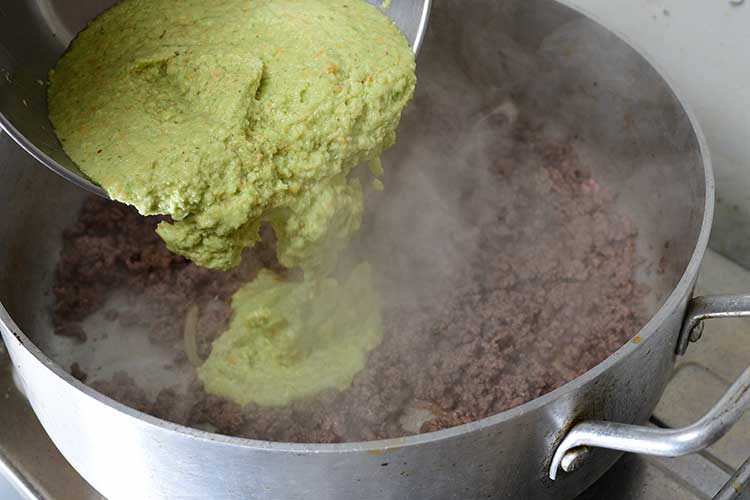
Now add the dried shrimp and the fish flakes. Stir in.

Finally, add in the spinach leaves, mix them in and bring the whole mixture to a boil. Lower the heat, and let the pot simmer for 15-20 minutes. Keep an eye on the moisture levels, and add a bit more water if you think the mixture is starting to dry out.
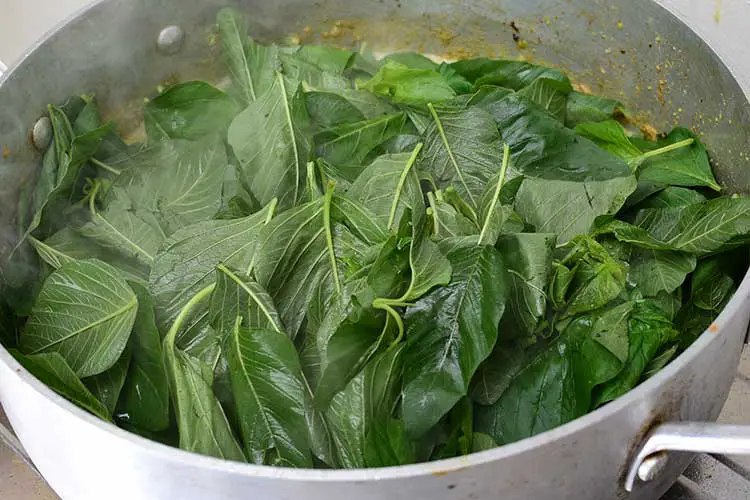
Once it’s cooked, season your stew, then transfer to a serving dish and add the shrimp and onions on top. You can serve it with a side of fried plantains, or even just some rice. We think a nice warmed flatbread could be a good option too, to soak up the sauce and all the flavor of the stew.
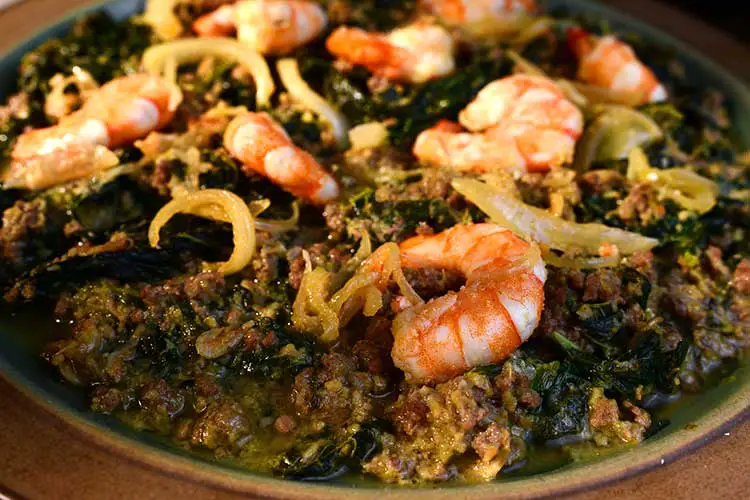
OUR TAKE ON THE RECIPE
There’s a legend in Cameroon that says a really good ndolé must be dusted with a spell, a magic charm cast by the person making it. Ignorant as we are to the dark arts, we were even more pleased when our ndolé came out shining with no supernatural intervention.
We loved the creaminess of the peanut puree mixed in with the fishiness of the smoked fish and the dried shrimp, which really packed a flavor punch.
Like we already mentioned, we substituted ndolé leaves for spinach, and we opted for smoked milkfish instead of cod. To cut down prep time, we used pre-roasted peanuts, as raw ones would need to be soaked overnight.
Some Cameroonian recipes for Ndolé call for stew cuts of meat rather than ground beef. We decided to go with the latter to shorten cooking time and to more evenly distribute meat around the dish.
If (and most certainly when) we cook this dish again, we’re thinking of experimenting with coconut milk to create a more Asian vibe. There’s a very similar Filipino dish to ndolé called laing, which mixes taro leaves with meat and stews them in coconut cream. But for now, we’re plenty pleased with the traditional recipe too.
Enjoy!
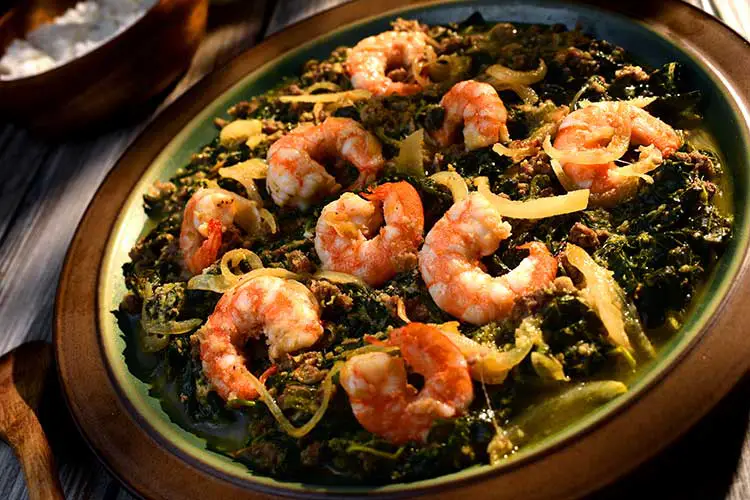

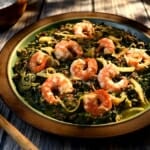
Ndolé: Cameroonian Peanut Stew
- Total Time: 45 minutes
Ingredients
- 1 lb (~500g) spinach
- 2/3 lb (~300g) ground beef
- 1/2 lb (250g) fresh shrimp
- 1/4 lb (~100g) smoked fish, deboned and flaked
- 1/4 lb (~1oog) roasted peanuts
- 2 tbsp (30g) dried shrimp
- 1 bunch spring onions
- 1 onion, peeled and roughly chopped
- 1 onion, thinly sliced
- 6 cloves garlic, peeled and crushed
- 2-inch piece ginger, thinly sliced
- 2 tablespoons olive oil
- 2 cups (500ml) water
- Salt, to taste
- Pepper, to taste
Instructions
Step 1 – Create Your Ndolé Paste
- Start your ndolé by creating your fragrant base of roasted peanuts, chopped onions, garlic, ginger, and water in a blender. Once you’ve gotten a nice paste, turn off your blender and set it aside.
Step 2 – Cook Your Shrimp
- Take a deep pot over medium-high heat and add in your olive oil. As the bottom of the pan starts to get hot, add in two tablespoons of olive oil and your sliced onions.
- As your onions start to soften 1-2 minutes later, add in your shrimps. Cook the shrimps for 2-3 minutes as they start to develop a nice pink color, but be careful not to overcook them or else they’ll become stringy and dry.
- Set aside your cooked shrimp and onions for the time being as we move onto the meat.
Step 3 – Move onto the Meat and Spinach
- In the same pan, next add the ground beef and sear the meat as it starts to brown.
- Once the meat has browned, add your pureed peanut mixture into the pan, mixing it well into the meat.
- If you’d like, here you can add your dried shrimps and smoked fish flakes to give your ndolé some added flavor.
- Add in all your spinach leaves and bring your ndolé to a boil.
- Once the ndolé has started to boil, lower your stovetop heat to a simmer and let it cook for 15-20 minutes. Keep an eye on the moisture levels, and add a bit more water if you feel that the ndolé is starting to dry out.
Step 4 – Finishing Touches
- Once your ndolé is cooked, season it with salt and pepper to your liking, then take it off the heat and transfer it to your serving dish.
- Finally, add your cooked shrimp and onions on top, and enjoy! Ndolé can be eaten with a side of fried plantains, rice, or even some good old flatbread.
- Prep Time: 15 min
- Cook Time: 30 min
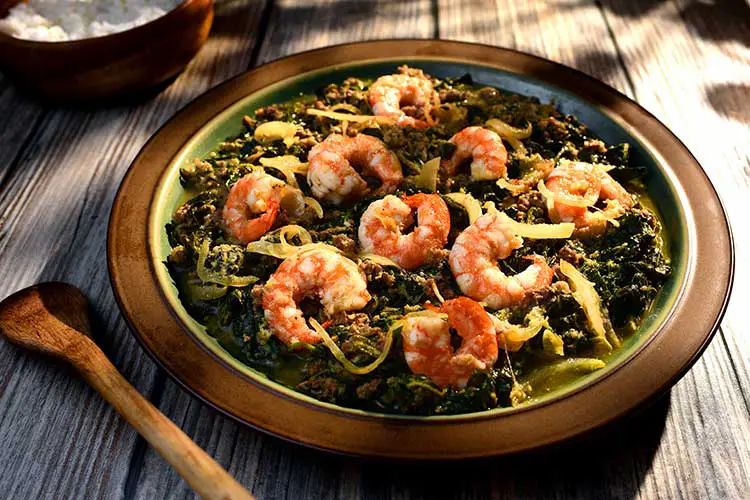

This recipe is not it unfortunately. Ndole is made with peeled boiled peanuts or peeled peanuts soaked in water not roasted peanut. Again nowhere in Cameroon is Ndole made with ground beef like your recipe states. And somewhere you mentioned Ndole can be made with pumpkin seeds; no that’s inaccurate. Using pumpkin seeds automatically makes it something else not Ndole. And lastly Ndole is not a popular dish in Nigeria, Ghana, Togo, or Benin, like you mentioned above. It is a popular Cameroonian dish. It is a good thing that you are trying to introduce African dishes into American households like you said but it would be only fair if you put out recipes and info that are accurate . Thank you
Please for the sake of the Sawa gods, what you just prepared is not ndole. This is your roasted peanut soup……🙆♀️🙆♀️🙆♀️
THIS IS NOT NDOLE, STOP DISRESPECTING CULTURE